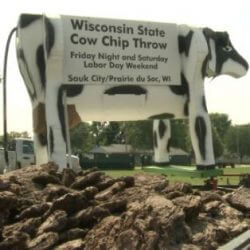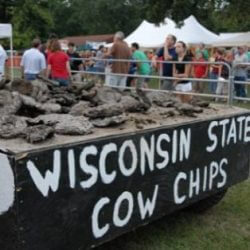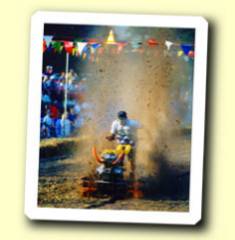Wisconsin State Cow Chip Throw
On the Friday and Saturday before Labor Day, a festival known as the Wisconsin State Cow Chip Throw takes place in Sauk City/Prairie du Sac, Wisconsin. An estimated 40,000 people attend each year. The current record for a throw is 248 feet, set by Greg Neumaier of Sauk Prairie in 1991. The women’s record is 157 feet, 5 inches, set by Oak Creek’s Terry Wallschleger of Oak Creek in 2005.
Perhaps a little background will help explain the historical significance of the cow chip and the genesis of the festival.

The pioneers who settled the Plains in the 1800s faced cold winters with little water and timber. Hunters had discovered that dried buffalo dung patties, or chips, could be burned for fuel. They were odorless and burned with intense heat and no soot.
The buffalo were all but gone by that time, hunted out of existence, so settlers gathered cow chips and stored them for winter when they would rely on them to warm their homes and keep their cooking fires burning. The chips were so valuable that they were often used to barter for food and other provisions.
In 1970, organizers of the Cimarron Territory Celebration in Beaver, Oklahoma, trademarked the “World Championship Cow Chip Throw,” requiring other towns wishing to host an “official” throw to certify their events with the Beaver Chamber of Commerce. (So far, it has authorized throws in South Dakota and Illinois, as well as Wisconsin.)
In 1975, the Sauk Prairie Jaycees declared the Sauk Prairie area as the Cow Chip Capital of Wisconsin and, with Beaver’s blessings, organized the first Wisconsin State Cow Chip Throw. In 1989, the Wisconsin State Legislature proclaimed the cow chip the Unofficial State Muffin.

According to the Wisconsin State Cow Chip Throw Committee, the following rules apply to today’s Corporate Throw and tomorrow’s Men’s and Women’s Throws. In the event of a dispute, the Chip Judge has the final say.
- Each contestant must choose two chips from the wagon-load provided by the official Meadow Muffin Committee.
- Chips shall be at least 6 inches in diameter.
- Of the two chips, the one thrown the farthest shall count.
- If a chip breaks up during the throw or while in the air, the piece that travels the greatest distance will be scored.
- Any attempt to alter the shape of a chip—except in rare instances when a loose fragment may be removed, provided the removal does not render the chip less than 6 inches in diameter—will result in a 25-foot penalty. The decision of the Chip Judge will be final.
- While no gloves may be worn while throwing, licking your hands is allowed to get a better grip.
That last one is optional, folks.

 Today is National #2 Pencil Day. Though this holiday’s provenance is unclear, there’s no question that this classic writing instrument has made its mark on history. (Sorry, had to do it.)
Today is National #2 Pencil Day. Though this holiday’s provenance is unclear, there’s no question that this classic writing instrument has made its mark on history. (Sorry, had to do it.)
 June 25, 2016: Today is the World Championship Rotary Tiller Race, the main event of the
June 25, 2016: Today is the World Championship Rotary Tiller Race, the main event of the